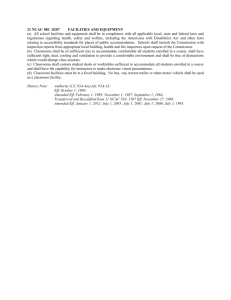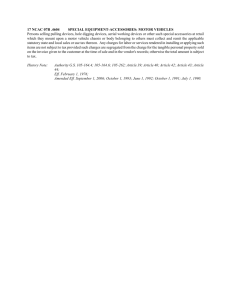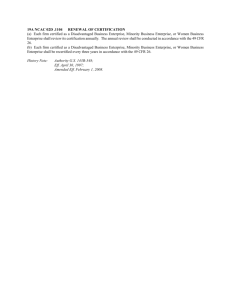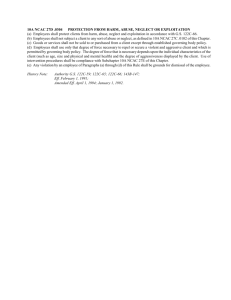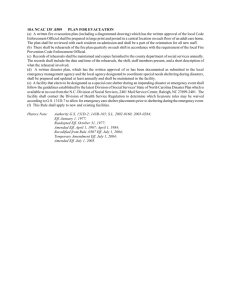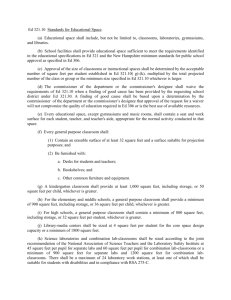SUBCHAPTER 11H ‑ CONTINUING CARE FACILITIES 11 NCAC
advertisement
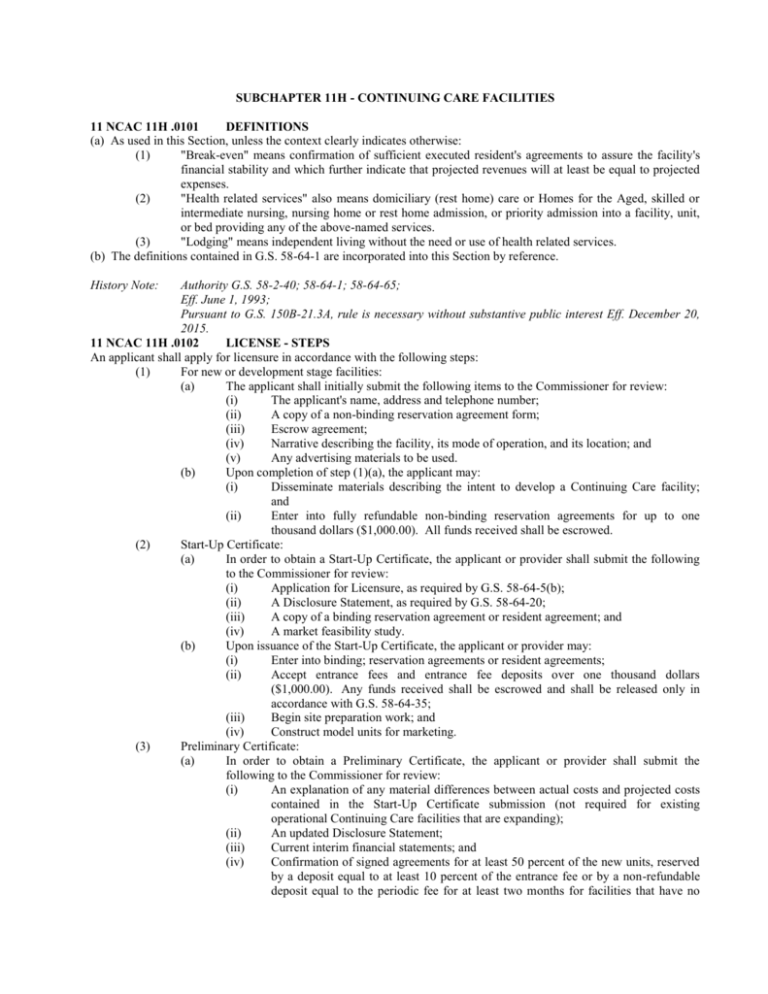
SUBCHAPTER 11H - CONTINUING CARE FACILITIES 11 NCAC 11H .0101 DEFINITIONS (a) As used in this Section, unless the context clearly indicates otherwise: (1) "Break-even" means confirmation of sufficient executed resident's agreements to assure the facility's financial stability and which further indicate that projected revenues will at least be equal to projected expenses. (2) "Health related services" also means domiciliary (rest home) care or Homes for the Aged, skilled or intermediate nursing, nursing home or rest home admission, or priority admission into a facility, unit, or bed providing any of the above-named services. (3) "Lodging" means independent living without the need or use of health related services. (b) The definitions contained in G.S. 58-64-1 are incorporated into this Section by reference. History Note: Authority G.S. 58-2-40; 58-64-1; 58-64-65; Eff. June 1, 1993; Pursuant to G.S. 150B-21.3A, rule is necessary without substantive public interest Eff. December 20, 2015. 11 NCAC 11H .0102 LICENSE - STEPS An applicant shall apply for licensure in accordance with the following steps: (1) For new or development stage facilities: (a) The applicant shall initially submit the following items to the Commissioner for review: (i) The applicant's name, address and telephone number; (ii) A copy of a non-binding reservation agreement form; (iii) Escrow agreement; (iv) Narrative describing the facility, its mode of operation, and its location; and (v) Any advertising materials to be used. (b) Upon completion of step (1)(a), the applicant may: (i) Disseminate materials describing the intent to develop a Continuing Care facility; and (ii) Enter into fully refundable non-binding reservation agreements for up to one thousand dollars ($1,000.00). All funds received shall be escrowed. (2) Start-Up Certificate: (a) In order to obtain a Start-Up Certificate, the applicant or provider shall submit the following to the Commissioner for review: (i) Application for Licensure, as required by G.S. 58-64-5(b); (ii) A Disclosure Statement, as required by G.S. 58-64-20; (iii) A copy of a binding reservation agreement or resident agreement; and (iv) A market feasibility study. (b) Upon issuance of the Start-Up Certificate, the applicant or provider may: (i) Enter into binding; reservation agreements or resident agreements; (ii) Accept entrance fees and entrance fee deposits over one thousand dollars ($1,000.00). Any funds received shall be escrowed and shall be released only in accordance with G.S. 58-64-35; (iii) Begin site preparation work; and (iv) Construct model units for marketing. (3) Preliminary Certificate: (a) In order to obtain a Preliminary Certificate, the applicant or provider shall submit the following to the Commissioner for review: (i) An explanation of any material differences between actual costs and projected costs contained in the Start-Up Certificate submission (not required for existing operational Continuing Care facilities that are expanding); (ii) An updated Disclosure Statement; (iii) Current interim financial statements; and (iv) Confirmation of signed agreements for at least 50 percent of the new units, reserved by a deposit equal to at least 10 percent of the entrance fee or by a non-refundable deposit equal to the periodic fee for at least two months for facilities that have no (4) (5) History Note: entrance fee. Applicants that do not accept presale entrance fees shall place a deposit with the Commissioner. The deposit shall be either one hundred dollars ($100.00) for each unit for 50 percent of the total proposed units, or one hundred thousand dollars ($100,000), whichever amount is more. The deposit shall be made in accordance with G.S. 58-5-20. The deposit shall be refunded to the applicant upon receipt of a permanent license. (b) Upon issuance of the Preliminary Certificate, the applicant or provider may: (i) Purchase or construct a Continuing Care facility; (ii) Renovate or develop structure(s) not already licensed as a Continuing Care facility; and (iii) Expand existing Continuing Care facilities in excess of 10 percent of the current number of available Independent Living Units (ILU's) or available health related units/beds. Permanent License: (a) In order to obtain a Permanent License, the applicant or provider shall submit the following to the Commissioner for review at least 60 days before the facility opening: (i) An updated Application for Licensure; (ii) An updated Disclosure Statement; and (iii) Confirmation of signed agreements for new units required by the Continuing Care facility to break-even, reserved by a deposit equal to at least 10 percent of the entrance fee or by a non-refundable deposit equal to the periodic fee for at least two months for facilities that have no entrance fee. (b) Upon issuance of the Permanent License and satisfaction of all other legal requirements, the applicant or provider may: (i) Open the Continuing Care facility; and (ii) Provide Continuing Care. Restricted or Conditional License: (a) If all other licensing requirements are met, the Commissioner shall, in lieu of denying the issuance of a Permanent License, issue a Restricted or Conditional License to an applicant when one or more of the following conditions exist: (i) A hazardous financial condition. (ii) Occupancy at the facility, or the number of executed agreements for new units at the facility, is below the level at which the facility would break-even. (b) Upon issuance of the Restricted or Conditional License, the provider may operate the facility under the conditions or restrictions established by the Commissioner until such time as the Commissioner alters the conditions for continued operations or issues a Permanent License. (c) Upon issuance of the Restricted or Conditional License, the provider shall file with the Commissioner quarterly financial statements and an occupancy report. These shall be due no later than 45 days following the end of each fiscal quarter. Authority G.S. 58-2-40; 58-64-5; 58-64-65; Eff. April 1, 1993; Amended Eff. September 1, 2007; July 1, 2004; Pursuant to G.S. 150B-21.3A, rule is necessary without substantive public interest Eff. December 20, 2015. 11 NCAC 11H .0103 REVOCATION OF LICENSE The revocation process, as provided by G.S. 58-64-10, shall also apply to the Start-Up Certificate, the Preliminary Certificate, and the Restricted or Conditional License. History Note: Authority G.S. 58-2-40; 58-64-10; 58-64-65; Eff. April 1, 1993; Pursuant to G.S. 150B-21.3A, rule is necessary without substantive public interest Eff. December 20, 2015. 11 NCAC 11H .0104 SALE OR TRANSFER OF OWNERSHIP The sale or transfer process, as provided by G.S. 58-64-15, shall also apply to the Start-Up Certificate, the Preliminary Certificate, and the Restricted or Conditional License. History Note: Authority G.S. 58-2-40; 58-64-15; 58-64-65; Eff. April 1, 1993; Pursuant to G.S. 150B-21.3A, rule is necessary without substantive public interest Eff. December 20, 2015. 11 NCAC 11H .0105 STANDARDIZED DISCLOSURE STATEMENT FORMAT As per G.S. 58-64-20(d), the Commissioner may prescribe a standardized format for the Disclosure Statement. The format shall be maintained by the Commissioner, and may be updated as necessary. History Note: Authority G.S. 58-2-40; 58-64-20; 58-64-65; Eff. April 1, 1993; Pursuant to G.S. 150B-21.3A, rule is necessary without substantive public interest Eff. December 20, 2015. 11 NCAC 11H .0106 HEALTH AND FINANCIAL CONDITIONS FOR ACCEPTANCE The health and financial conditions for acceptance as a resident shall appear within the Disclosure Statement, as provided by G.S. 58-64-20(a)(8). The Disclosure Statement shall also include any conditions related to the acceptance conditions required by the provider or facility, such as age, ability to move or communicate, minimum assistance levels necessary to perform daily activities, prepared wills, and ability to pay under specified conditions. History Note: Authority G.S. 58-2-40; 58-64-20; 58-64-65; Eff. April 1, 1993; Pursuant to G.S. 150B-21.3A, rule is necessary without substantive public interest Eff. December 20, 2015. 11 NCAC 11H .0107 FINANCIAL STATEMENTS AND COMPILED FIVE YEAR FORECASTS Certified financial statements, as required by G.S. 58-64-20(a)(10), and compiled five year forecasts, as required by G.S. 58-64-20(a)(12), shall be of the provider's corporation or other legal entity that owns the Continuing Care facility. The Commissioner may also require the provider to supply supplementary financial data or other appropriate disclosure under the requirements of G.S. 58-64-20(a)(10) and G.S. 58-64-20(a)(12) on individual Continuing Care facilities, where a corporation or other legal entity owns various Continuing Care facilities or is engaged in various enterprises. History Note: Authority G.S. 58-2-40; 58-64-20; 58-64-65; Eff. April 1, 1993; Pursuant to G.S. 150B-21.3A, rule is necessary without substantive public interest Eff. December 20, 2015. 11 NCAC 11H .0108 COMPILED FIVE YEAR FORECAST (a) The compiled five year forecast shall consist of the following: (1) a balance sheet; (2) a statement of operations; (3) a statement of cash flows; and (4) a narrative detailing all significant assumptions. (b) The balance sheet shall include individual categories or line items that sum into the following sub-totals, at a minimum: (1) current assets; (2) restricted assets, including a line item for operating reserve assets; (3) fixed assets, including property, plant, and equipment; (4) total assets; (5) current liabilities; (6) long-term debt; (7) total liabilities; (8) deferred revenue-refundable; (9) deferred revenue-nonrefundable; (10) equity or fund balance-unrestricted; and (11) equity or fund balance-restricted. (c) The statement of operations shall include the following individual categories or line items, at a minimum: (1) monthly fee revenues; (2) amortization of entrance fees; (3) health care revenues; (4) investment/interest income; (5) contributions/gifts; (6) health care expenses; (7) operations expenses, consisting of at least maintenance, laundry, and housekeeping; (8) dietary expenses; (9) administrative expenses; (10) interest expenses; and (11) depreciation. History Note: Authority G.S. 58-2-40; 58-64-20; 58-64-65; Eff. April 1, 1993; Pursuant to G.S. 150B-21.3A, rule is necessary without substantive public interest Eff. December 20, 2015. 11 NCAC 11H .0109 PROPOSED OR DEVELOPMENT STAGE FACILITIES The Commissioner may apply all or part of G.S. 58-64-20(a)(14) to existing Continuing Care facilities that are expanding. History Note: Authority G.S. 58-2-40; 58-64-20; 58-64-65; Eff. April 1, 1993; Pursuant to G.S. 150B-21.3A, rule is necessary without substantive public interest Eff. December 20, 2015. 11 NCAC 11H .0110 CONTRACT SPECIFICATION - LIVING UNIT A "living unit," as described in G.S. 58-64-25(a)(2), means an independent living unit or a health care unit/bed, or as otherwise defined by the annual North Carolina State Medical Facilities Plan. History Note: Authority G.S. 58-2-40; 58-64-25; 58-64-65; Eff. April 1, 1993; Pursuant to G.S. 150B-21.3A, rule is necessary without substantive public interest Eff. December 20, 2015. 11 NCAC 11H .0111 INSOLVENCY OR HAZARDOUS FINANCIAL CONDITION (a) A negative fund balance is a financial position of a provider or facility in which the assets of a provider or facility do not exceed its liabilities, as required under generally accepted accounting principles. The Commissioner may deem a provider or facility that has a negative fund balance to be insolvent or in imminent danger of becoming insolvent if any of the following hazardous financial condition standards or factors are applicable or present: (1) There are findings or conditions reported in the provider's or facility's financial statements that the Commissioner determines to be adverse to the financial stability of the provider or facility. (2) The current or projected ratios of total assets, including required reserve levels, to total liabilities indicate an impairment or a deterioration of the provider's or facility's operations or equity; or demonstrate a trend that could lead to an impairment or a deterioration of the provider's or facility's operations, working capital, or equity. (3) The current or projected ratios of current assets to current liabilities indicate an impairment or a deterioration of the provider's or facility's operations, working capital, or equity; or demonstrate a trend that could lead to an impairment or a deterioration of the provider's or facility's operations, working capital, or equity. (4) The provider or facility is unable to perform normal daily activities and meet its obligations as they become due, considering the provider's or facility's current or projected cash flow and liquidity position. (5) The provider's or facility's operating losses for the past year or projected operating losses are of such magnitude as to jeopardize normal daily activities or continued provider or facility operations. (6) The insolvency of an affiliated provider or facility or other affiliated person results in legal liability of the provider or facility for payments and expenses of such magnitude as to jeopardize the provider's or facility's ability to meet its obligations as they become due, without substantial disposition of assets outside the ordinary course of business, any restructuring of debt, or externally forced revisions of its operations. (7) The provider or facility has receivables that are more than 90 days old. (8) The insolvency is not temporary and the provider or facility cannot demonstrate that the insolvency is materially reduced or eliminated. (9) There is an adverse effect on the provider or facility of reporting entrance fees as deferred revenues, with consideration given to all reporting requirements required under generally accepted accounting principles and the ultimate net income component of those revenues. (10) A start-up provider or facility or any operational provider or facility undergoing plant expansion or refinancing of its debt has a financial condition as a result of such action that could otherwise seriously jeopardize present or future operations. (b) The provider or facility shall prepare a plan to address and correct any condition that has led to a determination of insolvency or imminent danger of insolvency by the Commissioner. The plan must be presented to the Commissioner within 90 days after the date of the insolvency determination. If the plan to correct the condition is disapproved by the Commissioner, the plan does not correct the condition leading to the Commissioner's determination of insolvency, or the provider's or facility's hazardous condition is such that it cannot be significantly corrected or eliminated, the Commissioner may then proceed under G.S. 58-64-10 or G.S. 58-64-45. History Note: Authority G.S. 58-2-40; 58-64-10; 58-64-45; 58-64-65; Eff. January 1, 1994; Pursuant to G.S. 150B-21.3A, rule is necessary without substantive public interest Eff. December 20, 2015.
